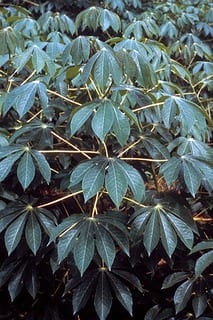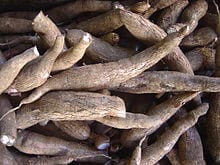
International teams are working to bring the starchy root’s genetics into the 21st century and help food-insecure countries
Cassava is a starchy, tuberous root first domesticated about 10,000 years ago in South America. Also dubbed manioc and yucca, cassava may be more familiar to North Americans as tapioca—tiny pearls of starch used to thicken pies and jams. For millions of people in the tropics, however, it is a staple, not a baking aid. Now, concerted efforts at crossbreeding and genomic selection have created novel versions of cassava that could dramatically boost yields, ward off malnutrition and grow in a wide range of conditions.
The typical cassava shrub produces unassuming brown roots with snowy white or creamy colored interiors. A cassava crop is perennial—after maturing for at least eight months roots can be harvested for a few years. New plants grow easily from cuttings. The root is carbohydrate-rich, protein-poor and must be boiled, roasted, fermented or otherwise processed to tame compounds that can produce toxic hydrogen cyanide during digestion. Nevertheless, an estimated 800 million people worldwide eat cassava. In Africa 500 million depend on the root as their main staple.
Because many cassava consumers live in developing countries, the plant has not received the intense breeding that has benefited crops more familiar to the Western world such as corn, wheat and rice. In the past decade, however, cassava has started to garner attention. China and Thailand use it to make high-quality starch, and some countries see the crop as a potential biofuel. What’s more, cassava will likely do well in the world’s changing climate; it survives drought when other crops have failed and flourishes in warmer temperatures.
Big boost in yield
Among the latest and most impressive breeding successes comes from Nagib Nassar, a cassava breeder and professor emeritus of genetics at the University of Brasilia. He has developed a new variety that could dramatically boost yields. Each of his plants produces about 14 kilograms of edible roots after one year whereas traditional varieties yield just two to three kilograms.
Apart from their massive roots, the new cassava plants don’t look too strange until examined under a microscope. Nassar has created chimeras—a fusion of two individuals—by carefully grafting a common cultivar with a wild species and treating the results with a synthetic plant growth hormone. The outer, or epidermal, layer of the new plants’ tissues is from cultivated variety and the inner tissues are from the wild parent.
Encouraged by the vigorous growth of the chimeras, Nassar hopes to investigate the possibility of more crosses. With his graduate student, Nayra Bomfim, he published a paper on the second chimera in the online journal Gene Conserve in January (pdf). “He is a tireless scientist,” says Hernan Ceballos, a cassava breeder at the International Center for Tropical Agriculture in Colombia. Ceballos, who was not involved in the work, adds that the chimeras are interesting but that further work to demonstrate the plants’ productivity is needed.
Nassar’s chimeras aren’t the only new cassava variety out there. Ceballos himself has been working on a variety that would tower high above future farmers’ heads. The “Asparagus Cassava” has no branches—its leaves grow directly from a massive stalk. This variety can be planted more densely than traditional cassava and produce higher yields. Other varieties include a cassava high in vitamin A, which turns the root orange, and one with extra protein.
Getting to the next generation
These promising varieties could be just the beginning in a cassava revolution.
The Latest on: Cassava revolution
[google_news title=”” keyword=”cassava revolution” num_posts=”10″ blurb_length=”0″ show_thumb=”left”]
via Google News
The Latest on: Cassava revolution
- Ekiti, Cavista Holdings sign multi-billion MOU to establish 100,000 hectares state-of-the-art cassava farmon May 10, 2024 at 2:14 am
The Ekiti State Government says it has signed a Memorandum of Understanding (MOU) with a leading Nigerian investment company – ...
- Cassava Sciences, Inc. Common Stock (SAVA) Insider Activityon May 7, 2024 at 5:00 pm
Data is not available at this time. Insider Trading information for NDAQ is derived from Forms 3 and 4 filings filed with the U.S. Securities and Exchange Commission (SEC). Please Note:An FPI is ...
- Cassava Sciences Inc SAVAon May 7, 2024 at 1:01 pm
SAVA INVESTOR ALERT: Bronstein, Gewirtz & Grossman LLC Announces that Cassava Sciences, Inc. Investors with Substantial Losses Have Opportunity to Lead Class Action Lawsuit!
- Cassava: The perilous past and promising future of a toxic but nourishing cropon May 6, 2024 at 9:00 am
However, fourth place is held by a dark horse: cassava. Over the course of millennia, Indigenous peoples bred it from a weedy wild plant into a crop that stores prodigious quantities of starch in ...
- Shifting weather patterns impact cassava yieldson May 5, 2024 at 5:00 pm
The Cassava crop that once covered more than 70 percent of the gardens as a leading commercial and food security crop in Nakasongola District has been reduced to less than half the production ...
- Cassava Sciences Inc.on April 29, 2024 at 5:00 pm
The Price to Earnings (P/E) ratio, a key valuation measure, is calculated by dividing the stock's most recent closing price by the sum of the diluted earnings per share from continuing operations ...
- Revolution had no answer for Messi magic: 5 takeaways from a 4-1 loss vs. Inter Miamion April 27, 2024 at 5:00 pm
The Revolution lost 4-1 to Lionel Messi and Inter Miami on Saturday night in front of a club record crowd (65,612) at Gillette Stadium. It was an entertaining game for the neutral fans — with ...
- Oyebanji unveils agribusiness initiativeon April 25, 2024 at 10:43 pm
Ekiti State governor, Biodun Oyebanji, has unveiled Cavista Holdings’ ‘Cassava Revolution’ in the state. According to a statement, the unveiling ceremony took place at a one-day retreat at ...
- How privateering worked in the American Revolutionon April 24, 2024 at 11:08 am
So shipowners and crews typically leaped at the chance to engage in privateering with 800 ships doing so in the American Revolution.
- Advancing CBSD resistance in cassava: a comprehensive review of breeding strategies and the role of new plant technologieson April 23, 2024 at 5:00 pm
Cassava, a staple for 800 million people, primarily grown in over 100 tropical and subtropical countries, faces significant yield challenges due to cassava brown streak disease (CBSD ...
via Bing News










